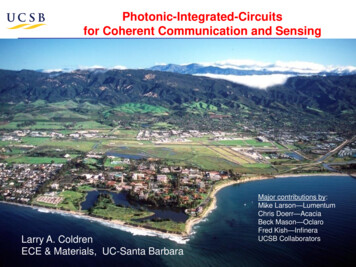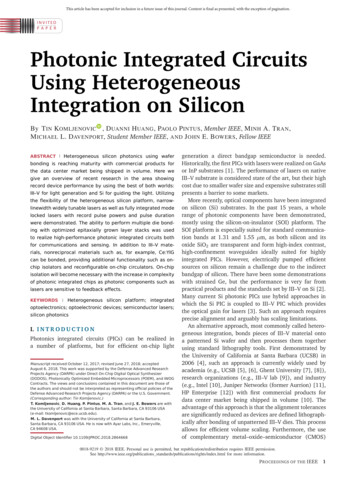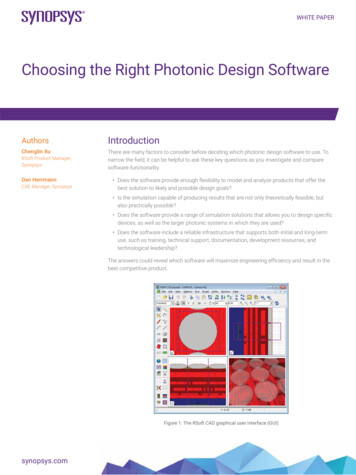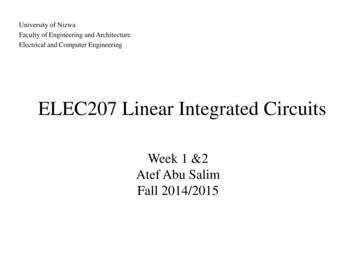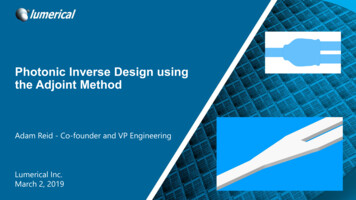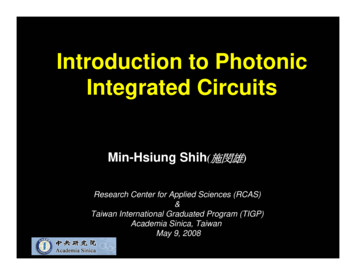
Transcription
Introduction to PhotonicIntegrated CircuitsMin-Hsiung Shih(施閔雄)Research Center for Applied Sciences (RCAS)&Taiwan International Graduated Program (TIGP)Academia Sinica, TaiwanMay 9, 2008Microphotonic Devices Group
Outlines Optical communication and photonic integratedcircuits Property of light Elements for optical communication system1)2)3)4)5)Lasers and amplifiersWaveguides and fibersModulatorsMultiplexer and Demultiplexer elementsPhotodectors Photonic crystal waveguide and bendingMicrophotonic Devices Groupstructures
Moore’s Law for ICsMicrophotonic Devices Group
Moore’s Law and CommunicationSpeedMicrophotonic Devices Group
Speed Limitation ofElectrical CommunicationsMicrophotonic Devices Group
Optical Communication SystemTypical DWDM (Dense Wavelength DivisionMultiplexing) systemMicrophotonic Devices Group
Elements for Photonic IntegratedCircuitsMicrophotonic Devices Group
Example of Photonic Integrated CircuitsPhotonic Integrated Circuitcombines tunable laser and optical modulator10/09/2007JDSU demonstrated a photonic integrated circuit (PIC) thatcombines a tunable laser and optical modulator, using atechnology known as the Integrated Laser Mach Zehnder (ILMZ).The PIC will allow the company to develop smaller, higherperformance and more cost-effective tunable solutions that supportfaster network speeds. Tunable lasers are a key element requiredor the deployment of agile optical networks (AON). Such networksare deployed by service providers to scale network infrastructuresand replace slow, manual operations with simplified, dynamicnetwork solutions that can quickly respond to fluctuating traffictraveling over fiber optic networks. Tunable lasers providedynamic reconfigurability by allowing network operators to switchfrom one wavelength to another on demand, easing the cost ofpurchasing, storing and managing spare devices for wavelengthmanagement. The chip includes a widely tunable laser and MachZehnder modulator on a single chip that is small enough to fit on thetip of a finger. It will be incorporated into full-band tunabletransponders and transceivers within compact packages, such asthe 300-PIN small form factor (SFF) and pluggable small formfactors (XFP) starting in 2008. This combination enables JDSUto support transmission speeds greater than 11.3 Gigabits persecond and is scalable to support 40Gbit/s networks.Microphotonic Devices GroupFrom www.epn-online.com
Photon vs. ElectronPhoton :Electron : For photonr( E , P ) (hν , 2π )λFor electronrh 2k 2( E , P) (, hk )2m Small interaction betweenthe photons Larger interaction betweenthe electrons Can propagate outside theguide medium Propagate only inside themedium or on the surfaceof the mediumMicrophotonic Devices Group
Optical WaveMaxwell’s equationsMicrophotonic Devices Group
Coherence of Light Incoherence light :Random phases kill thesignalsIncoherence Light λCoherence LightMicrophotonic Devices GroupCoherence light :The signal can propagate forlonger distance withoutinterferences. The laser lightis coherence.
Light SpectrumMicrophotonic Devices Group
Optical Waveguides Planar waveguide Rectangular (or linear)waveguide Cylindrical waveguideMicrophotonic Devices Group
Dispersion Relation of OpticalWaveguidesn3n1n2n1 n2 n3Microphotonic Devices Group
Optical WaveguidesGeometry of a Rib (Ridge) waveguidein planar photonic circuitsMicrophotonic Devices Group
Types of Optical Waveguidesn3n1n2 SEM image of a dielectric rib(ridge) waveguide The calculated mode profileMicrophotonic Devices Group
Optical Fiber High index core surround by lower index cladding The numerical aperture NA22NA (ncore ncladding)1/ 2Microphotonic Devices GroupNAsin α n0
Fiber vs. Cooper WireFiberMetalic wire cableMaterialSiOxCuLossLow (0.2 dB/km)High (20dB/km)SpeedHigh ( 10 GHz)LowBandwidthHighLowSizeSmallSmallWeightVery lightlightCrosstalk/InterferenceLowHighCostVery cheapCheapMicrophotonic Devices Group
Fiber Loss SpectrumMicrophotonic Devices Group
Types of Fiber Single-mode fiber (SM): 8-10 μm diameter Multi-mode fiber (MM): 50 μm diameter Polarization maintaincede (PM) fiber : special cross sectionMicrophotonic Devices Group
Semiconductor Lasers Laser types : Gas lasers, solid state lasers andsemiconductor lasers Why semiconductor lasers for opticalcommunication ? Advantages of semiconductor lasers1. Compact size2. Low threshold, low power consumption3. High-speed modulationMicrophotonic Devices Group
Direct Bandgap vs. Indirect Bandgap Energy conservation Momentum conservation Transition in the indirect band gap will include thephonon processMicrophotonic Devices Group
Why Silicon Photonics ?MaterialsIII-V materials ologyGoodMatureCompatible withelectric circuitsOKVery goodCostHighLowMicrophotonic Devices Group
Semiconductor Lasers – Edge-EmittingLaser Fabry-Perot cavityintroduces the resonantmodes for lasers Too many modesMicrophotonic Devices Group Low cost
Semiconductor Lasers – DFB Lasers Distributed feedback (DFB) laser Grating structure embedded in the Fabry-Perot structure Grating reduce the No. of modes, and work stable forcommunicationMicrophotonic Devices Group
Semiconductor Lasers -- VCSEL Vertical cavity surface emittinglaser (VCSEL) Smaller volume Well directly modulatedMicrophotonic Devices Group Low cost for package
Silicon Raman Lasers SOI substrate with a microring diameter 12 μm,height 250 nm and 200 nmgap Use p-i-n structure, dopingconcentration 1019 cm-3 Total Q 39000Microphotonic Devices GroupNature, vol 433, pp.725 (2005)
Optical Amplifiers - EDFAUse EDFA(Er3 ) for wavelength region ofDWDM systemMicrophotonic Devices Group
Optical Amplifiers - EDFA Erbium doped fiberamplifier (EDFA) Advantages1. Cover wide wavelengthrange2. Large total output power( 1000 mW)3. Large dynamic powerrange Disadvantages1. Not linear over theworking rangeMicrophotonic Devices Group2. Total power keepconstant for channels
Optical Amplifiers - EDFAErbium doped fiber amplifiers (EDFA)C-BandL-BandWavelength range1530-1565 nm1570-1605 nmTotal output power14-25 dBm14-25 dBmLength of active fiber10-60 m50-300 mMicrophotonic Devices Group
Optical Amplifiers - SOA Semiconductor opticalamplifier (SOA) Advantages1. For larger range ofwavelength2. Easy to integrate toother elements Disadvantages1. Lower output power(510 mW)2. Crosstalk influencesMicrophotonic Devices Group
Optical Modulators E-O modulator Mach-Zehnder modulator Micro-disk (Micro-ring) resonantModulatorMicrophotonic Devices Group
Optical Modulators – EO modulator Microphotonic Devices GroupElectro-optical (EO)modulatorApplied voltage tochange the phase ofpropagation fieldKDP( potassiumdihydrogenphosphate), LiNO3and etc.
Optical Modulators – MZ modulator Mach-Zehnder (MZ) structure for modulatorApply voltage to control phaseLiNbO3 , KDP are popular materialsMicrophotonic Devices Group
InGaAsP Microdisk Resonant Modulator Mico-disk integrated with 2waveguides InGaAsP active layer with a microdisk diameter 12 μm, and 800 nmcoupling distance Operated 8 GHzMicrophotonic Devices GroupIEEE PTL, vol 17, pp.567 (2005)
Different Types of Optical ModulatorsE-O eLargeCompactLargerSpeed 10 GHz 10 GHz 1 GHzVπHighLowLowCostLowHighLowMicrophotonic Devices Group
Demultiplexer ElementsPrism Not used in DWDM systemMicrophotonic Devices GroupDiffraction Grating Reflection light is nothomogeneous Not used in DWDM system
Demultiplexer Elementsλ (nm)Array waveguide grating (AWG) Array WGs make phase shift,and different focus in 2nd cavity Higher No. of channels ( 64) Small wavelength spacing Temperature dependence &higher costMicrophotonic Devices Groupλ (nm)
Multiplexer Elements Optical couplers1. Simple, low cost2. High insertion loss3. Never be a DeMUX Cascaded MachZehnders1. Easy integrated2. Can be MUX/DeMUXMicrophotonic Devices Group
Photodectectors in Photonic Circuits Transfer optical signals to electrical signals The opposite way to lasersMicrophotonic Devices Group
Photodectectors in Photonic Circuits Spectral response of different detector materials For fiber communication ( λ 1300-1550nm),InGaAs and Ge are prefer materials forphotodetectorsMicrophotonic Devices Group
End Microphotonic Devices Group
Microphotonic Devices Group
Microphotonic Devices Group
SOI Microdisk Resonant Modulator SOI substrate with a micro-ringdiameter 12 μm, height 250nm and 200 nm gap Use p-i-n structure, dopingconcentration 1019 cm-3 Can operated at 1.5 GHzMicrophotonic Devices GroupNature, vol 435, pp.325 (2005)
Building Blocks for Photonic IntegratedCircuits with 2D Photonic CrystalsLaser /Light SourceWaveguide / BendModulatorλ4, λ5, λ6 λ1, λ2, λ3 Microphotonic Devices GroupPhotodetector
May 09, 2008 · Example of Photonic Integrated Circuits Photonic Integrated Circuit combines tunable laser and optical modulator 10/09/2007 JDSU demonstrated a photonic integrated circuit (PIC) that combines a tunable laser and optical modulator, using a technology known as t

